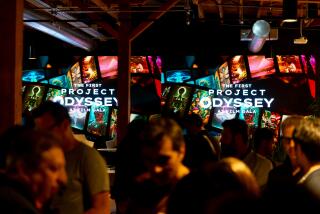Supercomputer Center Going Into Show Biz
- Share via
It’s not exactly going to be Hollywood’s “lights, camera, action,” but the San Diego Supercomputer Center is getting into the movie-making business.
Within weeks, the center will help scientists at the Research Institute of the Scripps Clinic transform the complex structure of the polio virus into a “movie.” The effort could help drug manufacturers create a safer vaccine for the virus that still afflicts hundreds of thousands of people each year.
In addition, scientists from the Scripps Institution of Oceanography will use the center’s incredibly fast Cray supercomputer to create a high-tech movie that will generate a better understanding of how weather patterns develop.
Computer renderings are the “icing on the cake” for researchers who are studying complex subjects, according to Arthur Olson, a senior staff scientist with the Research Institute’s Department of Molecular Biology.
Olson “couldn’t dream” of using the Research Institute’s otherwise speedy computer to animate the polio virus because a movie requires 24 frames per second and the institute’s computer takes as long as seven hours to churn out single slides.
Renderings “take a tremendous amount of time on a garden-variety computer,” Olson said. “But once you have a model, you want to communicate it to the widest audience as possible, and that requires a sophisticated rendering.”
“You might say that these are 30-second movies with a credit line that goes on for three hours,” quipped Michael E. Pique, a Scripps Clinic Research Institute scientist who has used the supercomputer’s film recording device to turn out a “movie” that will help researchers understand the architecture of enzymes. “It takes an awful lot of people and time to produce these things.”
Renderings also are important because super-fast supercomputers generate far too much data to be stored, according to Leonid Volfson, systems manager for the Scripps Institution of Oceanography.
Only a small percentage of the information generated by the Cray is stored, according to Volfson, who added that the “rest is gone, wasted . . . if data can be preserved in graph form, and if it can be shown in (motion) . . . you can actually see the flow of information.”
Volfson wants to use the computer to create an atmospheric model that illustrates how weather changes. Whereas existing models “might show what happened when a front was over Oregon and, hours later, when it was over Colorado, you need to know what was happening when, for example, it was over Utah.”
The Supercomputer Center hopes to acquire equipment and software that will allow scientists at remote locations to use the computer. Rather than merely watching the computer-produced movies, scientists will be able to stop the movies, run them backward, in slow motion, or even edit them--without help from computer technicians.
“A picture might be worth a thousand words, but pictures you can twirl around and play with are worth a million words at least,” Keeler said. “Giving scientists the ability to twirl them around in real time is our goal.”
Keeler hopes to craft an interactive system that will make the Cray’s movie-making capabilities easily accessible to scientists who link up with the UC San Diego Supercomputer Center through computers across the nation.
Developing a “new and unique method for scientists to analyze tremendous amounts of data is a very ambitious and very noble project,” according to Kevin Hussey, who has helped design an image animation facility at the Jet Propulsion Laboratory in Pasadena.
“If you’ve got 140 million (pieces) of data to manipulate and analyze, you need visual tools,” said Hussey, who added that “there’s a lot of work out there for anyone who can do it.”
“The people who specialize in graphics know how to (make) pictures but they’re not researchers,” Keeler said. “We want to make graphics available to scientific researchers as a more ‘self-service’ kind of thing.”
The computer-generated movies initially will benefit scientists, but industrial applications are not far behind:
- Farmers will use better weather data to maximize spring plantings and, subsequently, make accurate, worldwide grain production estimates. “That kind of information will have a direct impact on bread prices,” Volfson said.
Weather researchers hope that detailed, computer-generated graphics will help them develop that kind of forecasting expertise as they use movies to delve into the “motion of thunderstorms, studies of tornadoes, the monsoons in the Pacific and the El Nino,” Volfson said.
- Scientists will use movies to track how industrial air pollution spreads, creating a better understanding of which pollutants do the most environmental harm.
- Aviation safety experts will use computer-generated movies to help explain the atmospheric conditions that produce wind shears, the violent drafts that endanger airplanes as they take off and land.
- Hollywood already is using supercomputer-generated graphics to enhance movie-making. One computer company recently used the Supercomputer Center to produce scenes for a children’s fantasy movie.
- Researchers at the Agouron Institute in San Diego are using computer-generated graphics to create complex simulations of protein crystals and peptide hormones, according to Arnie Hagler, chairman of the La Jolla-based nonprofit research institute and chief executive officer of Biosym.
“There are all kinds of commercial and industrial uses, and there are lots of people who are very excited,” Volfson said.
There also are down-to-earth benefits.
“People don’t want to know that there’s a 30% chance of rain tomorrow,” Volfson said. “They want to know that it’s going to rain from 8:30 a.m. to 9:45 a.m. and that it’s going to stop.”






